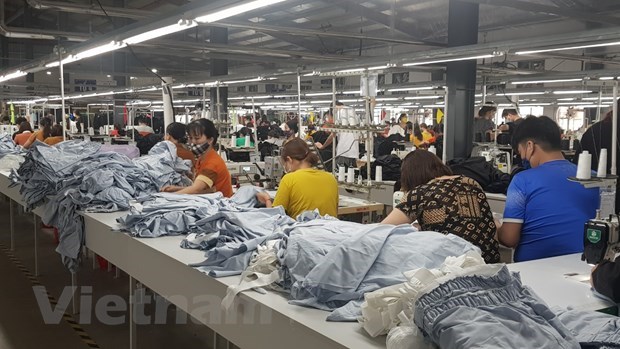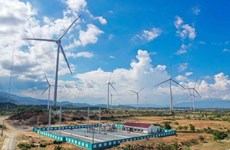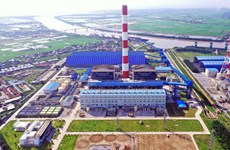FDI commitment rebound driven by greenfield investment surge
Experts from the World Bank (WB) suggested that Vietnamese monetary authorities consider further flexibility in the exchange rate, including a higher pace of depreciation.
 A garment factory in Vietnam (Illustrative photo: VietnamPlus)
A garment factory in Vietnam (Illustrative photo: VietnamPlus)Industrial production moderates, FDI bounces back
The WB said FDI commitment bounced back strongly thanks to a jump in greenfield investment in electricity, gas, and water supply, while FDI disbursement maintained robust growth.
Total investment commitment jumped to 3.7 billion USD in October, up 133% year on year and the second highest level in 2022. This improvement was driven by a lump sum greenfield investment of 2 billion USD in electricity, gas, and water supply.
FDI disbursement remained strong, growing by 8.1% (y/y) in October and 15.2% (y/y) over the first 10 months.
The industrial production index increased by 6.3% from a year earlier in October, compared to a 10.3% rate a month earlier. Part of the deceleration can be attributed to the dissipating low-base effects. However, weaker external demand is likely to be another important factor, as growth in the EU, the US and China is slowing. The manufacturing PMI fell from 52.5 in September to 50.6 in October 2022, staying just above the 50 benchmarks but reaching the lowest reading since October 2021, corroborating the deceleration in manufacturing growth.
Retail sales increased 17.1% in October, compared to the 32.3% rate a month earlier. On the one hand, as with industrial production, this sharp slowdown is partly due to waning low-base effects. On the other hand, it also reflects weakening domestic demand as the consumption rebound experienced in the first three quarters of the year appears to be fading amid rising inflation.
Sales of goods increased by 9.6% (y/y), which was lower than pre-pandemic growth rates of around 12%. Sales of accommodation, catering, and travel services, which had exceeded the pre-pandemic level as of August 2022, grew by 12.2%, lower than in October 2019.
After a strong recovery between March and August 2022, international tourism plateaued in September and October.
The merchandise trade balance registered a surplus in October, but export growth slowed. Exports growth slowed to a 12-month low of 4.8% (y/y) as external demand weakened amid high inflation, tightening global financial conditions, and heightened global uncertainties.
Further flexibility in exchange rate could be considered
Despite falling fuel prices, CPI inflation increased from 3.9% (y/y) in September to 4.3% in October, driven by a faster rise in food prices which account for 21.3% of the CPI basket.
The average petrol import price dropped for the fourth month in a row (down 9% month on month) and is expected to help ease inflationary pressure in the domestic market. The price of imported fertilisers also fell by 15% from the previous month, almost to the level observed a year ago. The price of steel also fell for the third month (down 8.5% m/m) and 20.3% lower than the level a year earlier. Although the price of imported coals increased by 18.7% (m/m) after three months of decline, it was only 3.3% higher than a year earlier.
Credit growth moderated to 16.5% (y/y) in October. This slowdown reflected the impact of the State Bank of Vietnam tightening domestic financial conditions. Average overnight interbank interest rate reached a new record high of 5.8% in October from 4.9% in September 2022. The rate also became more volatile in October, according to the report.
Amid the tightening of global financial conditions and the strengthening of the US dollar, as of November 3, the Vietnamese currency, VND, had lost 9.1% of its value against the USD since the beginning of this year. However, this pace of local currency depreciation was lower than other currencies.
Given strong pressure on the local currency, on October 17, the SBV increased exchange rate flexibility by widening the VND/USD trading band for the first time since August 2015, from +/- 3% to +/- 5%. The central bank also raised two key policy interest rates by another 100 basis points in October.
The economy faces strong headwinds. Slowing external demand and tightening global financial conditions are affecting the exchange rate. Rising inflation and tightening financial conditions could affect domestic demand during the next months.
As the US Federal Reserve is expected to continue raising interest rates, Vietnamese monetary authorities could consider allowing further flexibility in the exchange rate, including through a higher pace of depreciation of the reference rate. This could be complemented with continued use of reference interest rates, especially if faster depreciation leads to higher inflation and inflation expectations rise. Given the persistence of exchange rate pressures, direct foreign exchange sales should be used judiciously to preserve the foreign exchange reserves. Fiscal and monetary policy coordination will be critical to ensure price stability in light of accelerating domestic core inflation, the WB said./.












